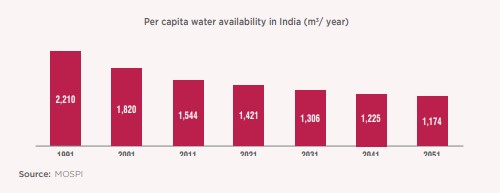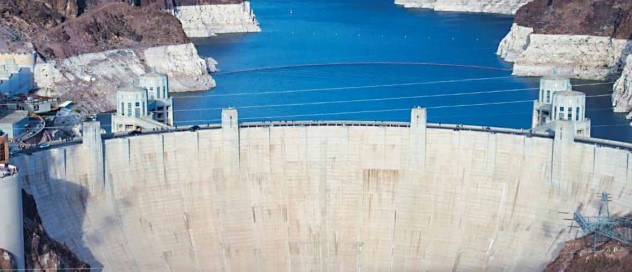Emerging Sectors
Water Management and Commercial Ferries/Shipbuilding

Water Management
Water is fundamental to life. However, this seemingly endless resource is under severe threat around the world. Growing populations, changing consumption patterns and climate change have resulted in extreme water shortages and it is predicted that by 2040, at least 33 countries, including India and Australia will face extremely high strains on their existing water reserves482. If the current levels of consumption without adequate conservation are not changed, two thirds of the global population will face acute water shortages as early as by 2025483.
India is running out of water at a rapid pace. The per capita availability of water has dropped from 5,177 cubic metres in 1951 to merely 1,545 cubic metres in 2011. India is therefore encouraging solutions in water conservation, ranging from desalination plants to smart water management systems.

The Department of Agriculture, Cooperation & Family Welfare (DAC&FW) of India implemented the Pradhan Mantri Krishi Sinchayee Yojana-Per Drop More Crop (PMKSY-PDMC) for enhancing water usage efficiency and promoting micro-irrigation systems such as drip and sprinkler
irrigation systems. In addition to this, micro-water storage structures, drought-proofing, and groundwater replenishment measures and restoration potential of existing water bodies were also promoted by this program.
Existing groundwater reserves in India are also being utilized aggressively. Preparing for a future with considerably less water resources is a serious issue that therefore requires urgent attention and concrete steps to address this issue. India and Australia, while possessing different industrial, economic, geographic and cultural traits, can put up a united front to tackle this global phenomenon.
Unlike India, Australia does not depend extensively on rainfall for its water requirement, as rainfall is highly variable in the country, both in terms of volumes and geographic distribution. ~40% of the country receives rainfall less than 300 mm per annum484. Several regions in Australia are severely drought-prone. There are also large distances between water bodies
and resident populations in Australia. Water harvesting, storage and distribution have therefore been essential to urban and rural development in the country.
Collaboration on water management is not new to India and Australia. In December 2004, five leading Australian universities (University of South Australia, Adelaide University, Flinders University, Central Queensland University and Deakin University) together with financial
support from the South Australian Government, were awarded Federal Government funding from the Department of Education, Science and Training to establish an International Centre of Excellence in Water Resources Management (ICEWaRM) in Adelaide485. ICE Warm creates
synergies between three core areas for water conservation, which include water resources management, education and training and international development. It is globally recognized for its leadership in developing sustainable solutions for water and economic development.
The states of South Australia and Rajasthan already have a sister state agreement in place and have established a Centre of Excellence in Water Resources Management (RaCE Warm) with water conservation as their core priority.486 It is a two-way partnership for exchange of research, policy and technical capabilities.487 The partnership led to a successful evaluation of
a disinfection plant in a 400-student accommodation unit in Jaipur that is being installed in other parts of India as well. Other states, such as NSW have also established Memorandums of Understanding (MoUs) with Maharashtra and Gujarat.
The Maharashtra Water Resources Department and the NSW Department of Primary Industries have signed an AUD 800,000 (USD 536,000) contract for water management and knowledge sharing on water governance488.
The Ironwood Institute in Australia has also worked with the Government of Rajasthan to establish ecosystems around hydroponics, which is a technique used in the cultivation of vegetables without using soil and using at least 10 times less water than traditional field cropping methods.
Source: ICE WaRM, Annual Review, 2018
International Water Resources Association (IWRA) is a non-profit, non-Governmental, educational organization established in 1971 in Wisconsin, USA and has an executive office in Paris, France. It provides a global, knowledge-based forum for bridging disciplines and geographies by connecting professionals, students, individuals, corporations and institutions who are concerned with the sustainable use of the world’s water resources489. The IWRA published a report, in collaboration with several institutes such as Commonwealth Scientific and Industrial Research Organisation (CSIRO), which provides a series of case studies for Smart Water Management (SWM). Indian state Governments can also collaborate with CSIRO490 in its research efforts that include various kinds of sensors, geographic information systems (GIS), satellite mapping and data sharing tools for water conservation491.
Further, Australia has several companies in the recycling sector that are focused on providing sustainable solutions to recycle water, waste and energy. These companies also have several innovative solutions focused on reducing pollution and recycling of construction waste and stormwater. India can collaborate with these companies for knowledge and technology
transfers.
Commercial Ferries/Shipbuilding
India has an extensive coastline and is ranked as the sixteenth largest maritime country in the world. ~90% of India’s trade (by volume) is carried out via the maritime route492. India’s ships carried ~7% of the global overseas trade by volume.493 ~92% of this global overseas cargo was carried out by global shipping companies operating in India. The current Indian fleet requires upgradation in technology and size. Thus, in order to realize the economic potential of the maritime industry, India will be required to further build its capabilities in shipbuilding, ports and relevant maritime infrastructure. Moreover, the Indian Government has undertaken several initiatives to increase the share of coastal shipping and inland water
transportation in the country under the ongoing ‘Sagarmala’ project, which will witness an investment of USD 123 billion in 415 projects, import modernization, new port development, port connectivity enhancement, port-linked industrialization and coastal community development.
In all these projects, Australia could participate as a partner.
The Australian maritime industry is globally recognized for its innovative and modern manufacturing capabilities and designs. The shipbuilding and maintenance repair overhaul (MRO) segment is expected to be valued at AUD 3.8 billion with exports accounting for 7% of the revenue as of March 2018. Australian companies have gained a reputation for their
workmanship, sea ferrying capabilities, fuel economy and other manufacturing advantages. A number of Australian companies like Austal, Incat and Strategic Marine operate in this sector. Incat Tasmania is globally recognized for building the fastest ship in the world running on LNG. The heavy investment made in research and development has given Australian companies the edge when compared with other players in this space in the world494.
Moreover, realizing the commercial potential of India’s inland waterway network, the Government of India has announced the development of National Waterways across 111 rivers across the country495. Out of the 111, 3 waterways, viz., National Waterway -1 (Ganga-BhagirathiHooghly river system from Allahabad to Haldia), National Waterway-2 (River Brahmaputra from Dhubri to Sadiya) & National Waterway-3 (West Coast Canal from Kottapuram to Kollam along with Udyogmandal and Champakara Canals) are already operational.
Coastal and inland water transportation, is a focal area of the Indian Shipping Ministry India can consider leveraging technology developed by Australia for building specialized aluminum vessels such as high speed ferries, fishing boats, patrol boats, cruise vessels and defense vessels. With the government’s ambitious plans to develop this sector, the requirement for ferries and ships in the country is expected to increase. India can partner with Australia to develop expertise regarding design of vessels appropriate for inland waterways and vessels driven by alternate fuels like LNG. India is currently in need of Foreign Direct Investment for inland waterway vessels, coastal shipping vessels and specialised small ships/ ferries. Investment is also required in coastal shipping under the ‘Sagarmala’ project. There is a requirement for collaboration and design of LNG coastal carriers. Australian companies should be encouraged
to examine all these possibilities. A bilateral group comprising of experts from the shipbuilding sector of the two countries can be formed for knowledge transfer. Further, Indian companies can partner with Australian companies such as Austal, which has significant contracts in Vietnam
and China for ferry building. While highlighting the availability of cost efficient skilled labour, India can position itself as a manufacturing destination for innovative Australian technology.
This would help to cater to the growing Indian market, as well as to develop competitive products for the world market.
Recommendations
- Indian government should encourage Australian companies like Austal, Incat and Strategic Marine to invest into ship building in India. India can position itself as a manufacturing destination for innovative Australian technology.
- A bilateral group with Australian experts can be set-up to facilitate knowledge transfer regarding vessel design and building of vessels.
- Indian government should collaborate with organizations like CSIRO for research and development in water management technologies.

485 ICEWaRM Website
486 India Business Mission and RaCE WaRM opening, ICE WaRM
487 South Australia signs Sister-State agreement with Rajasthan India, Austrade
488 Finding a ‘state mate’ may be the key to deeper economic relations, 2017, Department of Foreign Affairs and Trade
489 IWRA
490 Environmental informatics, CSIRO
491 IWRA Promotes Smart Water Management for SDGs, 2019, IISD
492 Sagarmala Website, Government of India
493 Shipping: Industry and outlook, Care rating, 2018
494 Australia’s Capability in Commercial Shipbuilding and Services, Austrade 2017
495 Ministry of Shipping - India
Next topic: